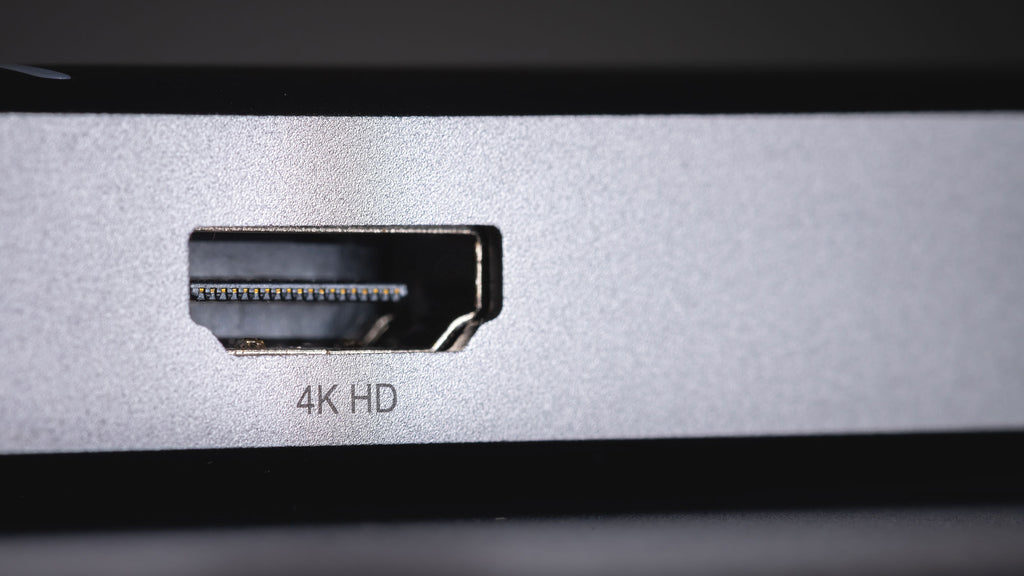HDMI 2.0: Its Powerful 4k Video and Gaming Specs
October 09, 2022 6 min read
Out of 7 versions of HDMI, HDMI 2.0 is a real treasure. Not only is it compatible with the majority of home-used devices, but also supports 4k video and uncompressed audio – producing sound waves that hit your sense.

Even its sub-version HDMI 2.0b inaugurated the HLG video display (explained later). This read will precisely elaborate the HDMI 2.0 so you’ve got a bundle of fresh knowledge to use before deciding which device you should invest in. It will also tell you how you can add caffeine to your gaming experience.
Before writing this article, I realized, that you might not consume the valuable information I am about to present unless we’ve got a benchmark to start.
So…
What was going on before the release of HDMI 2.0?
Wasn't HDMI 1.4 Good Enough?
Compared to outclass features introduced by HDMI 2.0, HDMI 1.4 seems a fossil of the past. To begin with, HDMI 1.4 had sheer enmity with pixel, for it couldn't support anything beyond 1080p, and even failed to handle 4k as the frame rate increased. Just slide your eyeballs down and observe how the improved frame rate polishes the image.

But mere video quality isn’t the only factor when it comes to HDMI, Bandwidth, and color depth equally play an important role.
Here Are The Other Key Features of HDMI 1.4
With 10.2 Gbps bandwidth, HDMI 1.4 provided ease of data transfer coming from internet devices, gaming consoles, Blu-ray players, and other A/V receivers. The more HDMI is able to carry data, the better it is for ideal performance on screen.
Moreover, HDMI 1.4 has an 8-bit color depth. Do you want to know how the color depth beautifies the image and shines every inch of your screen? Stay tuned. You are about to be amazed.
What is HDMI 2.0
Launching of HDMI 2.0 aptly testify the proverb, “ necessity is the mother of all inventions”. In 2013, the audio-video industry was revolutionizing. Visual enhancements such as UHD, and penetration of the sound bar and gaming consoles at the grass root level fired the need for one cable that could support audio, video, and ethernet.
So, what better does it offer?
On the visual side, HDMI 2.0 appears to be a real hero. With a color depth of 12 bits, it is empowered to enlighten every pixel to its total capacity. It has boosted visual experience to the point where every part of your body receives goosebumps.
How does the color depth phenomenon operate?
During the purchase of a screen (TV/ Monitor) you might’ve heard the term 8-bit color or 12-bit color. Compared to 8-bit which yields a color palette of 17.7 million, 12-bit handles a whopping 69.7 billion color palettes.
However, if that data is not smoothly transferred, the video quality will not be good. Getting technical? Look at the image below to get the gist of how improved color depth enhances image quality.

HDMI 2.0 supports higher color bit
With 18 Gbps HDMI 2.0 can comfortably support high resolutions at a higher frame rate.
- 1080p (FHD) 120 Hz
- 2160 (UHD) 60 Hz
- 1080p 3D 120 Hz
The following link explains the pictorial illustration of the color depth and also reveals the major difference that sets HDMI 2.0 apart from HDMI 1.4.
HDMI 1.4 Vs 2.0: What is The Major Difference
HDMI 2.0 Audio specs.
HDMI 2.0 offer 32 uncompressed audio channels. Wait! It's technical, I know that.
You might be self-taking what the heck is this uncompressed sound. What benefits does it offer? And why the inclusion of uncompressed audio channels was hailed as a big success?
The real sound wave that has been captured, recorded, and directly converted to digital format makes up uncompressed audio. In short, uncompressed audio contains actual sound waves, pitch, and frequency. By adding 32 uncompressed audio channels in HDMI 2.0, we can now experience sound, songs, thrilling scenes, and gaming beats in their original condition.
What is HDMI 2.0 ‘a’ and ‘b’: Finding the Exact Difference
To begin with, changes have nothing to do with Cable. A cable is just a pipe, always ready to receive something coming from the source. In this regard, the version HDMI 2.0 was introduced to support High Dynamic Range (HDR) features most technologies were offering.
According to the HDMI Forum, HDR-enabled 2.0a enhanced video quality by adding details in bright and darker parts of the image.
But to precisely differentiate between HDMI 2.0a and 2.0b you need to understand the 4 standards of HDR, for the latter was introduced to support the most advanced HDR format.
Following are the Standards of HDR
- HDR10
- Dolby Vision
- HDR10+
- Hybrid log-gamma (HLG)
The inclusion of HLG support features introduced in HDMI 2.0b, is the only significant change that set it apart from HDMI 2.0. It is important to mention that screen’s refresh rate and pixel are closely related and unanimously work to increase video quality.
Related Stories
Types of HDMI Cables: Summery of Everything on the Internet
Does HDMI 2.0 Support 120Hz and 144Hz?
It is capable to support higher refresh rates of 120Hz and 144Hz. But bearing this high refresh rate results in the destruction of video quality. So, I can say, HDMI 2.0 and HDMI 2.0b boost visual experience up 144Hz but fails to ensure a silky smooth flow of video quality. Let's learn more about pixels.
Getting 4k With HDMI 2.0 Is Not As Simple As You May Think
The increased bandwidth of up to 18 Gbps results in a faster transfer of data into each pixel, resulting in crystal clear 4k image delivery on the screen. Thus, HDMI 2.0 is strong enough to produce 4k video at 50 and 60 FPS respectively.
But it's 4k@120Hz or 4k@144Hz that actually pumps energy in the video.
Unfortunately, you can get this with HDMI 2.0.
Yet, there is a quick trick that may stop you from undue spending to upgrade to HDMI 2.1.
In order to achieve 120/144 Hz, you’ll have to reduce the screen’s resolution to around 144 pixels (Quad HD) or 1080 pixels commonly referred to as FHD. This will serve your purpose. But For 4k at 144Hz, upgrade to HDMI 2.1.
In which situation should you upgrade to 144 Hz?
If your office work demands a large screen (for video editing or Coding, maybe), upgrading to 144 HZ is a good option. Also, for gaming, especially those which involve a one-person-shooter, 144 Hz is worth it. Not only does it provide a competitive edge over an opponent (who is at 60 Hz), but also adds pleasure to your gaming.
Is HDMI 2.0 Good For Gaming?
For HDMI cables to be tagged as good or bad, you need to answer this simple question. Which version of HDMI can pass maximum information at a given time?
In this connection we find HDMI 2.1 (48 Gbps) beating HDMI 2.0 (18 Gbps) which has half the bandwidth as the former. It suggests that while HDMI 2.0 is best for 4k gaming, it may not support your 8k gaming craze. For 8k, you must have HDMI 2.1.
Besides having 48 Gbps HDMI 2.1 supports VRR (a feature that gamers love). Tap on the following links to learn more about Next-Gen HDMI cable 2.1.
HDMI 2.0 Vs 2.1: Does HDMI 2.1 Make a Big Difference?
HDMI Vs DisplayPort: Which Is Perfect for Gaming / TV / Monitor
Final Words From Uni
Makers of HDMI have been introducing its versions since 2002 in search of better, sustaining, and continuous image, video, and audio results. The aim was to remove the cable mess by innovating a single A/V cable. But the advancement in the streaming industry forced to launch of succeeding versions with more bandwidth, audio channels, and support for 4k, now 8k. Although there is little source available in 8k, still, HDMI 2.1 is in the market to support 8k resolutions. Interestingly, this cable debate is ending once and for all as Wireless HDMI is gaining currency.
People Also Read
Leave a comment
Comments will be approved before showing up.
Also in Blog
How to Distinguish Low-Quality Electronic Waste on E-Commerce Platforms in 2025
March 19, 2025 3 min read
With the rise of online shopping, distinguishing between high-quality electronics and low-quality e-waste has become a critical skill. Many e-commerce platforms are flooded with questionable products that look appealing but often have serious quality and longevity issues.

Maximizing Your Internet Speed: The Ultimate Guide to Using a USB-C to Ethernet Adapter
July 12, 2024 4 min read
Read More Related Products
Related Stories
· What Is Optic Fiber HDMI Cable?
//
1. [Solved] USB C to HDMI Adapter Cable Not Working in 2022
2. Best Product for Remote Work and Entertainment
3. How to Set Up Dual Monitors for Laptop
4. How to use USB-C to HDMI Cable
5. How to spend time at home during the Covid-19 pandemic?
6. How to choose a suitable USB hub at a good price?
7. How does a 2.5G Ethernet Adapter work with my laptop?


